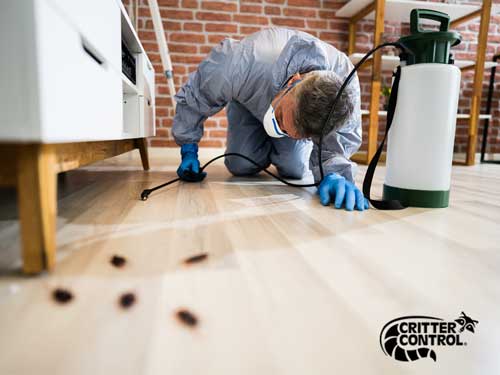Bed Pest Treatment Malfunction: Contrasting Chemical Vs. Non-Chemical Solutions
In the realm of pest control, especially when taking care of the relentless issue of bed bugs, the choice in between chemical and non-chemical therapy remedies can be a critical one. Both techniques supply distinct advantages and downsides, influencing factors such as performance, safety and security considerations, and overall price. By checking out the nuanced details of each approach, a clearer understanding of which path to seek in attending to a bed insect problem can be obtained.
Performance of Chemical Therapies
Chemical treatments for bed pest problems have actually been commonly identified for their powerful and fast efficiency in getting rid of these parasites. When considering the performance of chemical therapies, it is crucial to understand that they can give a fast and detailed solution to a bed insect problem.
Furthermore, chemical treatments have the benefit of using residual effects, meaning that they can remain to get rid of bed insects even after the first application. This recurring action is particularly useful in combating any potential re-infestations. Furthermore, the fast action of chemical therapies can bring relief to people dealing with extreme bed insect infestations, permitting them to restore control of their space swiftly.
Safety And Security Problems With Chemical Solutions
One critical aspect that needs cautious factor to consider when making use of chemical services for bed insect treatment is making certain the safety and security of passengers and the setting. While chemical treatments can be reliable in eradicating bed pests, they might posture threats otherwise managed effectively. Among the main safety and security issues with chemical services is the prospective damage they can trigger to human wellness. Exposure to certain chemicals used in bed bug therapies can lead to breathing problems, skin irritation, or other adverse responses, especially in people with pre-existing problems or sensitivities. Additionally, inappropriate application or dose of chemical pesticides can cause hazardous residues lingering in the cured location, posturing long-term health threats to passengers.
Moreover, the ecological impact of chemical remedies is another significant factor to consider. Some pesticides made use of in bed pest therapies may be damaging to advantageous pests, wildlife, and communities if they seep into the dirt or water systems. It is important to use chemical treatments carefully, complying with security standards, and thinking about much less harmful choices to alleviate these threats and make sure the safe and efficient management of bed insect problems.
Benefits of Non-Chemical Methods
Taking into consideration the prospective safety and security concerns and ecological impact connected with chemical remedies for bed pest treatment, checking out non-chemical methods presents an appealing choice with several distinct benefits. Non-chemical methods offer a more secure alternative for homes, especially those with youngsters, people, or pet dogs delicate to extreme chemicals. These approaches get rid of the threats of direct exposure to poisonous materials, reducing the capacity for negative health and wellness results. Additionally, non-chemical treatments are eco-friendly, as they do not add to air or water contamination, making them a lasting selection for bug control.
Additionally, non-chemical remedies can be reliable in targeting bed pests, consisting of hard-to-reach Find Out More areas where chemical therapies may not penetrate. Techniques such as heat therapy, vacuuming, vapor cleaning, and mattress encasements give comprehensive removal without making use of harmful chemicals. In addition, non-chemical techniques can be less turbulent, requiring minimal prep work and enabling for quicker reentry right into treated locations. Generally, choosing non-chemical bed bug therapy methods not only prioritizes safety and ecological protection however additionally makes certain thorough and efficient bug control.
Limitations of Non-Chemical Treatments

Furthermore, non-chemical therapies commonly require several applications to attain effective obliteration. This can be lengthy and may not constantly ensure complete removal of all bed pests and their eggs, specifically in hard-to-reach or concealed places.
In addition, the success of non-chemical treatments heavily relies upon appropriate implementation and thoroughness, which can be challenging for people without professional knowledge. Poor application of non-chemical methods might cause incomplete removal, bring about relentless invasions and the demand for added treatments.
For that reason, while non-chemical therapies have their advantages, it is necessary to recognize these limitations and consider them when establishing one of the most effective technique for taking care of bed bug invasions.
Expense Contrast: Chemical Vs. Non-Chemical Options
Provided the restrictions connected with non-chemical therapies, an important facet to examine in the context of bed bug management is the price comparison in between chemical and non-chemical options. In comparison, non-chemical treatments like warm treatment or steam can be a lot more termite service expensive, with costs ranging from $1,000 to $6,000 for an entire home. While the first expense of chemical therapies may seem reduced, multiple treatments might be needed to totally remove the infestation, potentially raising the general cost.
Conclusion

Thinking about the possible safety and security concerns and environmental effect linked with chemical options for bed bug treatment, discovering non-chemical approaches provides an encouraging alternative with a number of distinctive benefits.Offered the restrictions linked with non-chemical treatments, a crucial aspect to examine in the context of bed bug administration is the price comparison between chemical and non-chemical choices. In comparison, non-chemical treatments like warmth therapy or steam can be much more costly, with pop over here costs varying from $1,000 to $6,000 for a whole home. While the first price of chemical treatments may appear lower, several therapies might be required to fully eliminate the problem, possibly increasing the overall cost.In conclusion, when contrasting chemical and non-chemical bed pest therapy alternatives, it is vital to take into consideration efficiency, safety, advantages, limitations, and cost.